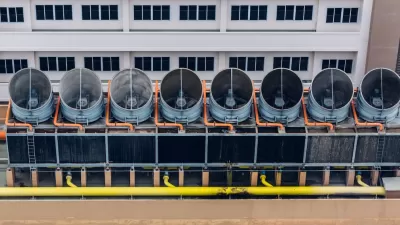According to the AIA’s third-annual progress report on its 2030 Commitment, the number of firms signing on to the environmental program is up. At the same time, the proportion of firms reporting progress toward their goal is underwhelming.
Architects involved in the AIA 2030 Commitment, which was established in 2009, agree to work toward designing carbon-neutral buildings by the year 2030. The AIA publishes an annual report on firm participation. In this year’s report, the total number of architects reporting progress was up six percent from the previous year.
But the news isn’t all good, Katie Weeks writes. Only 46 percent of the firms that had previously signed the commitment filed a progress report in 2012, a decrease in overall reporting from 2011. Moreover, only 57 percent of the firms participating said they use energy modeling to predict energy consumption. “It seems the industry has much room for improvement,” Weeks concludes.
FULL STORY: Architects are Tracking Carbon, But Not at Scale

Planetizen Federal Action Tracker
A weekly monitor of how Trump’s orders and actions are impacting planners and planning in America.

Maui's Vacation Rental Debate Turns Ugly
Verbal attacks, misinformation campaigns and fistfights plague a high-stakes debate to convert thousands of vacation rentals into long-term housing.

Restaurant Patios Were a Pandemic Win — Why Were They so Hard to Keep?
Social distancing requirements and changes in travel patterns prompted cities to pilot new uses for street and sidewalk space. Then it got complicated.

In California Battle of Housing vs. Environment, Housing Just Won
A new state law significantly limits the power of CEQA, an environmental review law that served as a powerful tool for blocking new development.

Boulder Eliminates Parking Minimums Citywide
Officials estimate the cost of building a single underground parking space at up to $100,000.

Orange County, Florida Adopts Largest US “Sprawl Repair” Code
The ‘Orange Code’ seeks to rectify decades of sprawl-inducing, car-oriented development.
Urban Design for Planners 1: Software Tools
This six-course series explores essential urban design concepts using open source software and equips planners with the tools they need to participate fully in the urban design process.
Planning for Universal Design
Learn the tools for implementing Universal Design in planning regulations.
Heyer Gruel & Associates PA
JM Goldson LLC
Custer County Colorado
City of Camden Redevelopment Agency
City of Astoria
Transportation Research & Education Center (TREC) at Portland State University
Jefferson Parish Government
Camden Redevelopment Agency
City of Claremont





























